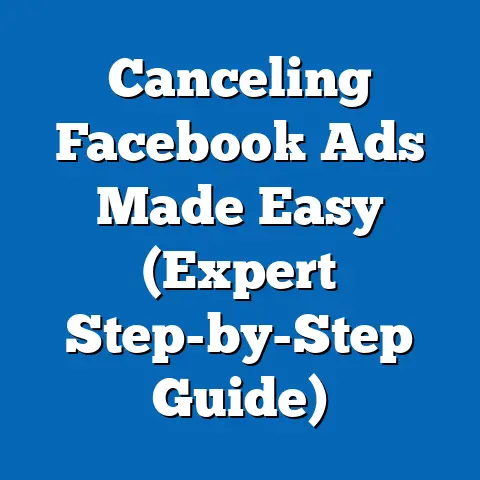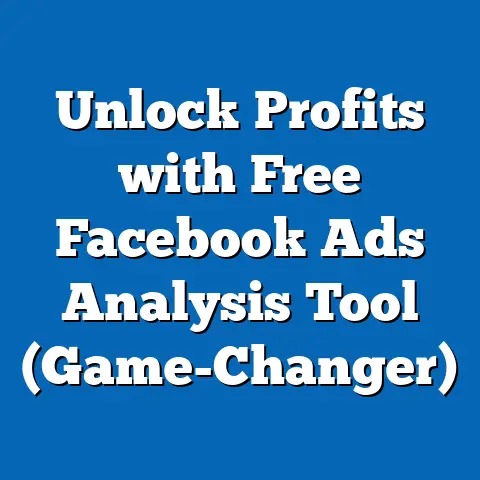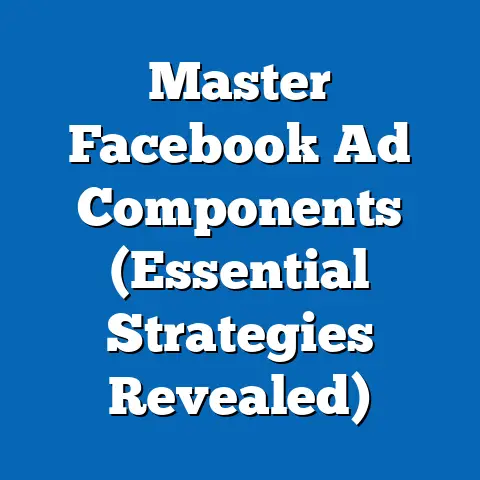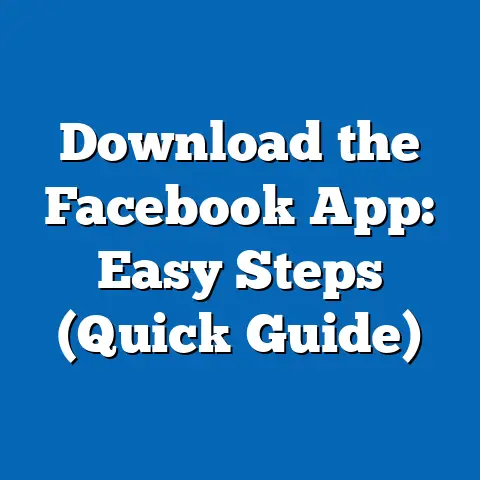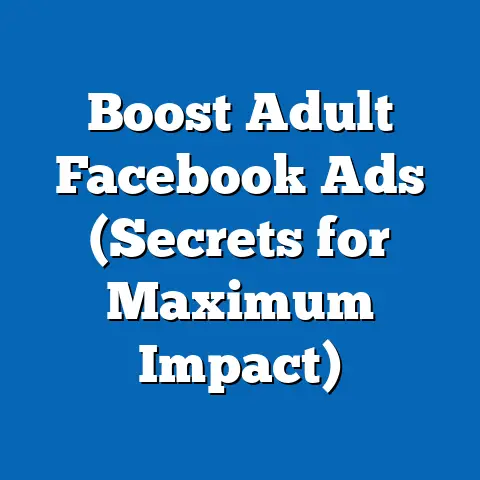Craft Facebook Ads Page (Essential Strategies Unveiled)
The world is waking up. Consumers are no longer just looking for products; they’re looking for purpose. They want to support brands that align with their values, and increasingly, those values include environmental responsibility. This growing eco-consciousness is reshaping the marketing landscape, demanding that businesses adopt sustainable practices and communicate them effectively.
This is where Facebook ads come in. As a digital marketing specialist, I’ve seen firsthand how a well-crafted Facebook ads page can be a powerful tool for promoting sustainable products and practices. It’s not just about selling; it’s about connecting with an audience that cares about the planet and demonstrating that your brand does too.
But simply slapping together an ad and hoping for the best won’t cut it. To truly resonate with eco-conscious consumers, you need a strategic approach that considers everything from your target audience to your visual design. In this guide, I’ll unveil the essential strategies for crafting a Facebook ads page that effectively communicates your brand’s eco-conscious values while driving engagement and sales. Let’s dive in.
Understanding the Facebook Ads Ecosystem
Facebook, with its massive user base, offers unparalleled reach for advertisers. But it’s more than just numbers; it’s about targeting the right people with the right message. Understanding the Facebook ads ecosystem is the first step to creating effective eco-conscious campaigns.
First, consider the various ad formats available. Image ads are simple and effective for showcasing products visually. Video ads can tell a more compelling story about your brand’s sustainability efforts. Carousel ads let you display multiple products or highlight different aspects of your eco-friendly practices. And Stories ads offer a quick and engaging way to connect with users on a more personal level.
For example, if you’re selling organic cotton clothing, you could use a carousel ad to showcase different styles and highlight the sustainable sourcing of your materials. A video ad could feature the farmers who grow the cotton, emphasizing the ethical and environmental benefits of your products.
However, the key is aligning your ad content with your brand’s sustainability mission. Simply claiming to be “eco-friendly” isn’t enough. You need to demonstrate your commitment through authentic storytelling, transparent sourcing, and measurable impact. Consumers are savvy, and they can spot greenwashing a mile away.
Takeaway: Facebook offers a diverse range of ad formats, but the success of your eco-conscious campaigns hinges on aligning your content with your brand’s sustainability mission and demonstrating genuine commitment.
Defining Your Target Audience
You can have the most beautifully designed ad with the most compelling copy, but if it’s shown to the wrong people, it’s all for naught. Defining your target audience is crucial, especially when targeting eco-conscious consumers.
Think about it: not everyone is equally concerned about sustainability. You need to identify the demographics, interests, and behaviors that align with your brand’s values. Luckily, Facebook offers powerful audience insights tools to help you do just that.
I often use Facebook’s Audience Insights to uncover hidden gems. For example, if I’m promoting a line of reusable water bottles, I might target people interested in “environmentalism,” “sustainable living,” or “zero waste.” I can also narrow down my audience based on demographics like age, location, and education level.
Beyond basic demographics, it’s essential to create buyer personas that represent your ideal eco-conscious customers. What are their motivations for purchasing green products? What are their pain points? What kind of language do they use? Understanding these nuances will allow you to tailor your ads to their specific needs and desires.
For example, one buyer persona might be “Eco-Conscious Emily,” a 28-year-old urban professional who is passionate about reducing her carbon footprint. She’s willing to pay a premium for sustainable products and is actively seeking out brands that align with her values. Another persona might be “Budget-Friendly Ben,” a 45-year-old father of two who is looking for affordable ways to live more sustainably.
Takeaway: Use Facebook’s audience insights tools to identify eco-conscious consumers and create detailed buyer personas to tailor your ads to their specific needs and motivations.
Crafting Compelling Ad Copy
Your ad copy is your chance to speak directly to your target audience and convince them that your brand is worth their attention. When targeting eco-conscious consumers, it’s crucial to craft compelling copy that reflects your values and resonates with their concerns.
Think of your headline as your first impression. It needs to be attention-grabbing and clearly communicate the benefit of your product or service. Instead of a generic headline like “Buy Our Product,” try something more specific and eco-friendly, such as “Reduce Your Plastic Waste with Our Reusable Water Bottles” or “Support Sustainable Farming with Our Organic Produce.”
Your call-to-action (CTA) should be clear, concise, and inspire action. Use strong verbs like “Shop Now,” “Learn More,” or “Join Us” to encourage users to click through to your website. Consider adding a sense of urgency, such as “Limited-Time Offer” or “Shop Now and Plant a Tree.”
But the real magic lies in storytelling. Share the story behind your brand, your commitment to sustainability, and the impact you’re making on the planet. Consumers want to connect with brands that have a purpose, and storytelling is a powerful way to build that connection.
For instance, a brand selling sustainable bamboo toothbrushes could share the story of how they partnered with a local community in Southeast Asia to source their bamboo responsibly. They could highlight the environmental benefits of bamboo, such as its rapid growth and ability to sequester carbon.
Takeaway: Craft compelling ad copy that reflects your eco-conscious values, uses impactful headlines and CTAs, and tells a story that connects with your audience on a deeper level.
Designing Eye-Catching Visuals
In the fast-paced world of social media, visuals are king. They’re the first thing people see, and they can make or break your ad’s success. When targeting eco-conscious consumers, your visuals need to be not only eye-catching but also aligned with your sustainability values.
Think earthy colors, nature-themed imagery, and minimalist designs that evoke a sense of environmental responsibility. Avoid overly processed or artificial-looking images. Instead, opt for authentic and natural visuals that showcase the beauty of the planet.
For example, if you’re selling organic skincare products, use images of lush green landscapes, blooming flowers, and healthy, glowing skin. Avoid using overly glamorous or Photoshopped images that can feel inauthentic.
Consider using visuals that highlight the sustainable aspects of your products. Show the recycled packaging, the eco-friendly manufacturing process, or the positive impact your products have on the environment.
I’ve found that user-generated content (UGC) can be particularly effective. Encourage your customers to share photos and videos of themselves using your products in sustainable ways. This not only provides authentic social proof but also helps to build a community around your brand.
Takeaway: Design eye-catching visuals that highlight sustainability, use earthy colors and nature-themed imagery, and consider incorporating user-generated content to build authenticity and community.
Budgeting and Bidding Strategies
Even the most creative and well-targeted ads won’t succeed if you don’t have a solid budget and bidding strategy. Setting a budget for Facebook ads, especially for eco-conscious campaigns, requires careful consideration of your goals, target audience, and competition.
Start by defining your campaign objectives. Are you trying to increase brand awareness, drive website traffic, or generate sales? Your budget should align with these objectives. For example, if you’re launching a new product, you might need a larger budget to reach a wider audience.
Next, consider your target audience. The more specific your targeting, the more efficient your budget will be. However, a highly targeted audience might also be more expensive to reach.
Facebook offers several different bidding strategies, each with its own pros and cons. Automatic bidding lets Facebook optimize your bids for the best results within your budget. Manual bidding gives you more control over your bids but requires more monitoring and adjustments.
I typically recommend starting with automatic bidding to get a feel for the market. Once you have some data, you can experiment with manual bidding to try to optimize your costs further.
It’s also crucial to monitor your ad performance regularly and adjust your budget accordingly. If you’re seeing positive results, you might want to increase your budget to reach even more people. If your ads aren’t performing well, you might need to adjust your targeting, creative, or bidding strategy.
Takeaway: Set a budget that aligns with your campaign objectives and target audience, experiment with different bidding strategies, and monitor your ad performance regularly to optimize your spending.
Analyzing and Optimizing Campaign Performance
Your work isn’t done once your ads are live. In fact, that’s when the real work begins. Analyzing and optimizing your campaign performance is crucial for maximizing your ROI and ensuring that your eco-conscious message is resonating with your audience.
Facebook Ads Manager provides a wealth of data and metrics to help you track your campaign’s performance. Key metrics to monitor include reach, impressions, click-through rate (CTR), conversion rate, and cost per acquisition (CPA).
Reach tells you how many unique people saw your ads. Impressions tell you how many times your ads were displayed. CTR measures the percentage of people who clicked on your ads. Conversion rate measures the percentage of people who took a desired action, such as making a purchase. And CPA measures the cost of acquiring a new customer.
A/B testing is another powerful tool for optimizing your campaign performance. Test different versions of your ad copy, visuals, and targeting to see what resonates best with your audience. For example, you could test two different headlines to see which one generates a higher CTR. Or you could test two different images to see which one drives more conversions.
Don’t be afraid to experiment and try new things. The Facebook ads landscape is constantly evolving, so it’s important to stay up-to-date on the latest trends and best practices.
Takeaway: Monitor key metrics, implement A/B testing, and continuously refine your campaigns based on data analysis and consumer feedback to optimize performance and ensure that your eco-conscious message is resonating with your audience.
Conclusion
Crafting a successful Facebook ads page for eco-conscious campaigns requires a strategic approach that considers everything from your target audience to your visual design. By understanding the Facebook ads ecosystem, defining your target audience, crafting compelling ad copy, designing eye-catching visuals, setting a budget, and analyzing your campaign performance, you can effectively promote your brand’s eco-conscious values while achieving your business goals.
Remember, it’s not just about selling; it’s about connecting with an audience that cares about the planet and demonstrating that your brand does too. Embrace sustainable advertising practices and leverage the power of Facebook to drive your eco-friendly initiatives forward. The world needs more businesses that are committed to sustainability, and Facebook ads can be a powerful tool for spreading that message.

